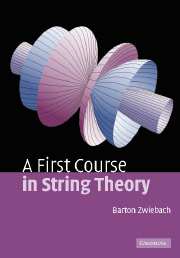Book contents
- Frontmatter
- Contents
- Foreword
- Preface
- Acknowledgements
- Part I Basics
- 1 A brief introduction
- 2 Special relativity and extra dimensions
- 3 Electromagnetism and gravitation in various dimensions
- 4 Nonrelativistic strings
- 5 The relativistic point particle
- 6 Relativistic strings
- 7 String parameterization and classical motion
- 8 World-sheet currents
- 9 Light-cone relativistic strings
- 10 Light-cone fields and particles
- 11 The relativistic quantum point particle
- 12 Relativistic quantum open strings
- 13 Relativistic quantum closed strings
- Part II Developments
- References
- Index
2 - Special relativity and extra dimensions
from Part I - Basics
- Frontmatter
- Contents
- Foreword
- Preface
- Acknowledgements
- Part I Basics
- 1 A brief introduction
- 2 Special relativity and extra dimensions
- 3 Electromagnetism and gravitation in various dimensions
- 4 Nonrelativistic strings
- 5 The relativistic point particle
- 6 Relativistic strings
- 7 String parameterization and classical motion
- 8 World-sheet currents
- 9 Light-cone relativistic strings
- 10 Light-cone fields and particles
- 11 The relativistic quantum point particle
- 12 Relativistic quantum open strings
- 13 Relativistic quantum closed strings
- Part II Developments
- References
- Index
Summary
The word relativistic, as used in the term “relativistic strings,” indicates consistency with Einstein's theory of special relativity. We review special relativity and introduce the light-cone frame, light-cone coordinates, and light-cone energy. We then turn to the idea of additional, compact space dimensions and show with an example from quantum mechanics that, if small, these dimensions have little effect at low energies.
Units and parameters
Units are nothing other than fixed quantities that we use for purposes of reference. A measurement involves finding the unit-free ratio of an observable quantity to the appropriate unit. Consider, for example, the definition of a second in the international system of units (SI system). The SI second (s) is defined to be the duration of 9 192 631 770 periods of the radiation emitted in the transition between the two hyperfine levels of the cesium-133 atom. When we measure the time elapsed between two events, we are really counting a unit-free, or dimensionless, number: the number that tells us how many seconds fit between the two events or, alternatively, how many periods of the cesium radiation fit between the two events. The same goes for length. The unit called the meter (m) is nowadays defined as the distance traveled by light in a certain fraction of a second (1/299 792 458 of a second, to be precise). Mass introduces a third unit, the prototype kilogram (kg), kept safely in Sèvres, France.
- Type
- Chapter
- Information
- A First Course in String Theory , pp. 12 - 39Publisher: Cambridge University PressPrint publication year: 2004



